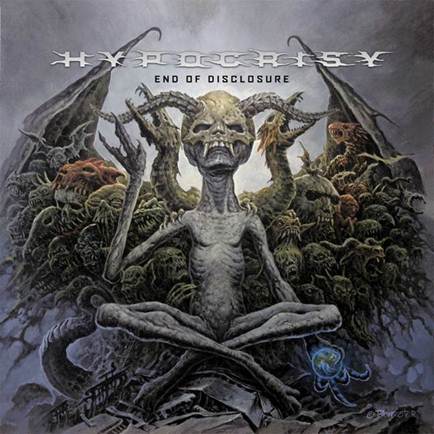
Album Review: Hypocrisy - "End of Disclosure"
Over the history of death metal, an awful lot of adjectives have been used to describe the genre’s fare; fast, loud, harsh, brutal, noisy, nasty, visceral, and increasingly as the subgenre develops, technical. Though many of them paint part of the picture, none of those words accurately describes the whole of Hypocrisy’s new album, “End of Disclosure.” The painted portions that do apply to the album rest dutifully on the canvas of another word, one never used in death metal except in very rare occasions; measured.
Truly, that is the enduring bedrock of “End of Disclosure.” Every moment, every beat, every riff, every chorus is thoughtful, planned, considered. Nothing is haphazard or colored outside the lines.
The impression the listener takes away is that lead man Peter Tägtgren actually advances through a number of phases within the album, moving his songs and his band through an assembly line of variable song types, each one executed with precision and aplomb.
It’s important to note that in no way should we confuse “measures” with “cautious” or “quiet.” “End of Disclosure” rotates through all the adjectives we mentioned at the top, each gear clicking in a sort of death metal decathlon.
Most unique of the album’s acts is “The Eye,” the entire midsection of which is populated with the sampling that Tägtgren and I discussed in the interview. It’s a refreshingly new concept in death metal, one that is heightened by the contrast with the scratchy vocals and deep guitars surrounding the dire speech.
But there’s more than just novelty to be had. Tägtgren is a man famous for big choruses and “End of Disclosure” does not disappoint. “44 Double Zero” and “Soldier of Fortune” are both noticeable in that they possess rich, full-bodied choruses that stand out from the heavy-handed riffing of the music throughout. This juxtaposition of power and hook is the hallmark of any Hypocrisy release, and doubles-down on “End of Disclosure.”
Yet we’re still not done. Not to be outdone, the album doesn’t forget to include some well-layered and pristine orchestrated guitar work, turning up the design elements for songs like “When Death Calls.”
As one might imagine, the versatility on display comes at the fair trade of consistency, so it’s unlikely that any single fan will adore every part of the record, and that’s if every part if perfect. As it is, “Tales of Thy Spineless” is an example of death metal falling short, as Hypocrisy loses sight of the melody and rhythm in favor of a sort of senseless noisemaking. Even the poorer selections on the record however are produced and executed with precision, it’s just that they explore avenues that Tägtgren need not worry about.
A cynic might also suggest that Hypocrisy would be well served to venture into borderless territory. While I personally think it unnecessary with so much quality on the buffet, one could make an argument that “End of Disclosure” simply represents the many faces of death metal without redefining any of them, and would have been more impacting if Tägtgren had ventured to break the molds. But with the excellent execution on “End of Disclosure,” you’d have to be knee-deep in pomposity to mention that in anything more than passing.
Peter Tägtgren has long been in the vanguard of death metal and while his role as innovator may have been usurped by newer (but not necessarily better) artists, his role as icon remains steadfast. Whether you’re a fan of PAIN or of Hypocrisy, “End of Disclosure” represents another capable chapter in the legacy of a man long under-appreciated outside his genre. “End of Disclosure” is far more accessible than most contemporary death metal records, and while long time fans are sure to enjoy it, people looking to see what the genre’s about would do well to use this as a baseplate.

